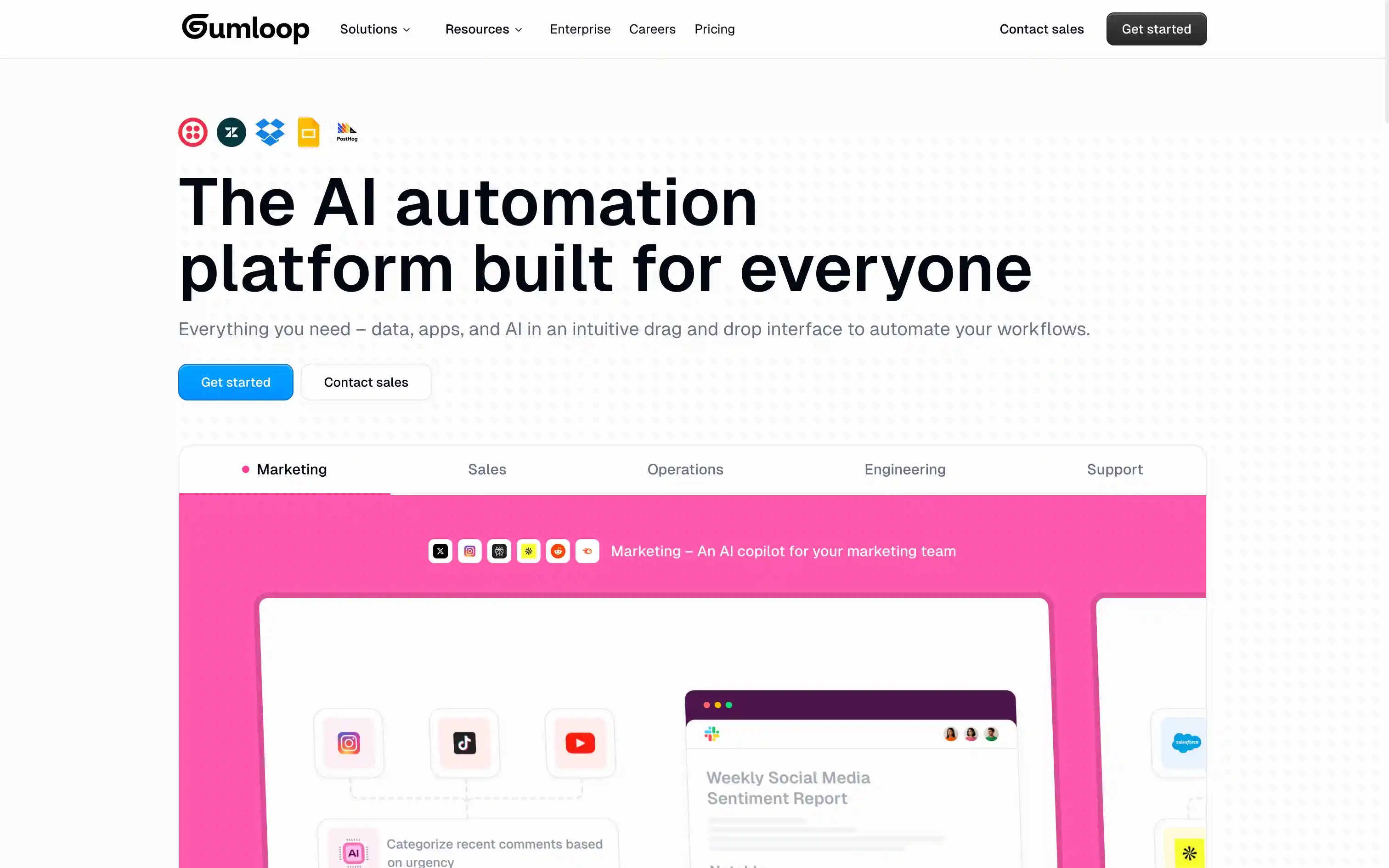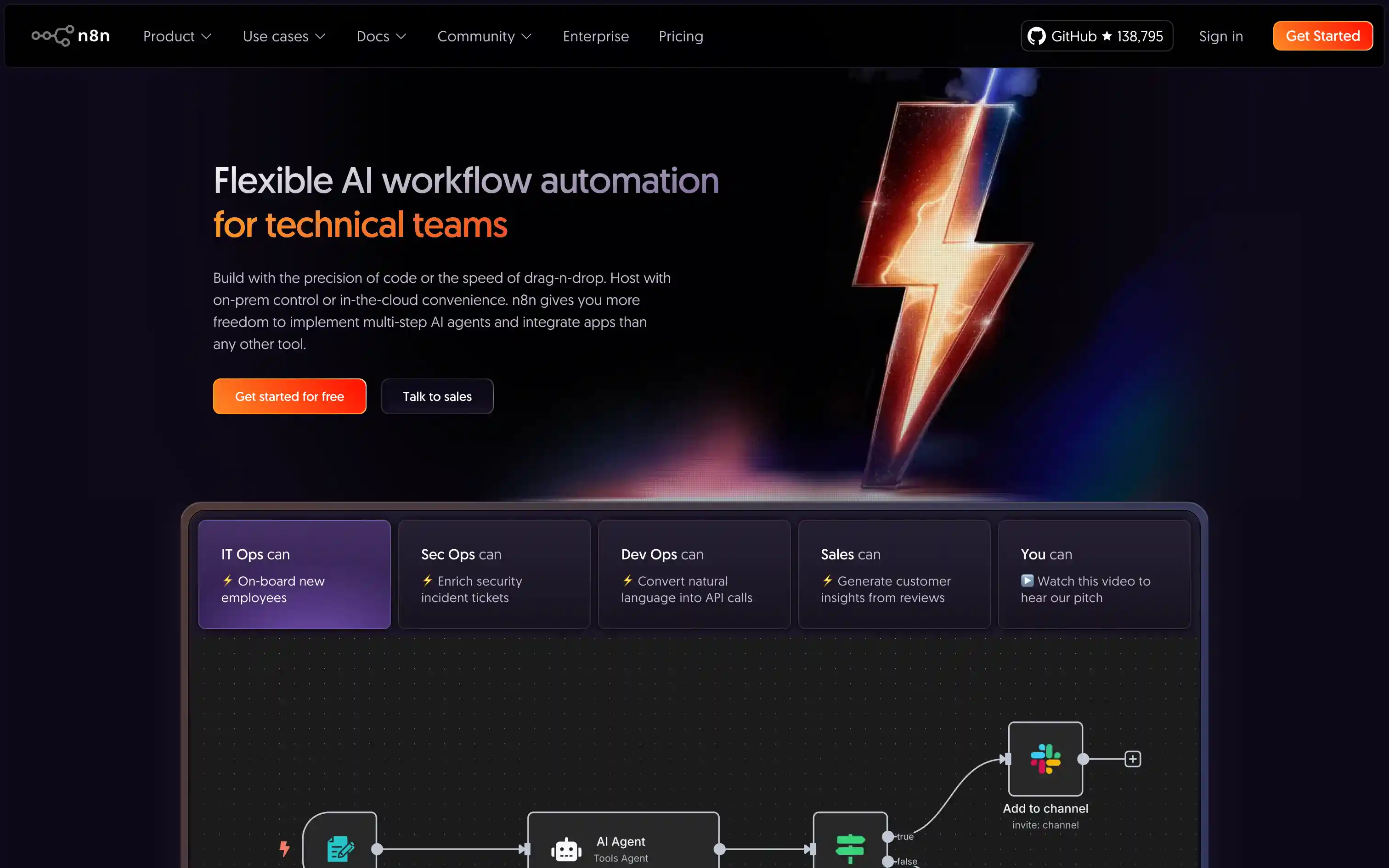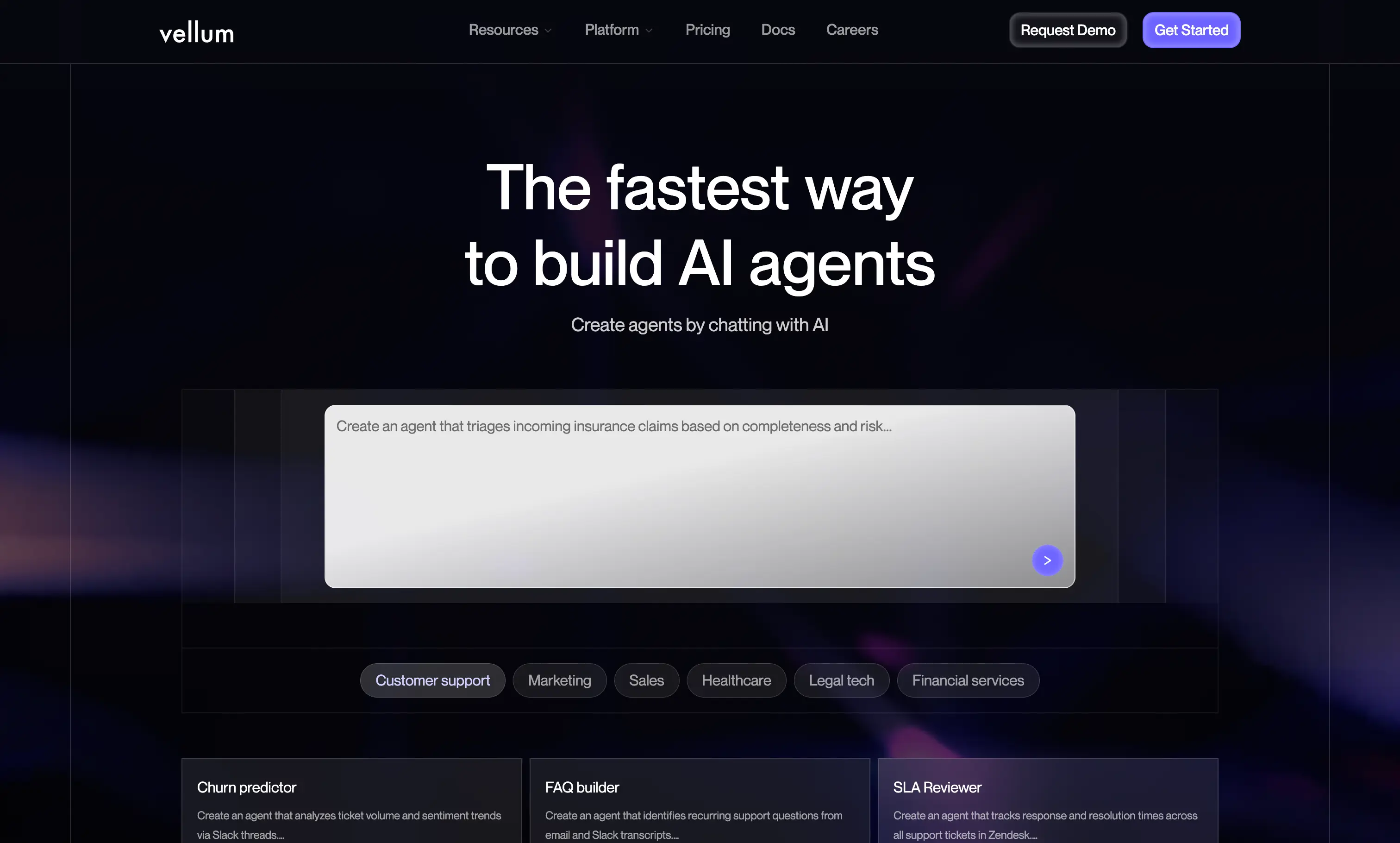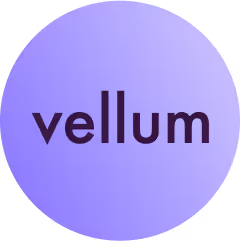Quick overview
Selecting the right AI automation platform is a critical decision. In a landscape filled with options, three distinct tools often come up: Gumloop for its no-code simplicity, n8n for its developer-centric power, and Vellum AI, which is designed to be the fastest and easiest way to build sophisticated AI agents. This guide breaks down the strengths and weaknesses of each platform, helping you understand which tool best aligns with your team's goals, technical expertise, and ambition.
- Choose Gumloop if your goal is simple, AI-powered task automation for non-technical users. It’s an excellent tool for getting started quickly with basic workflows.
- Choose n8n if you are a developer who requires maximum flexibility, control over your infrastructure, and are willing to manage the associated operational overhead for internal tools.
- Choose Vellum AI if your goal is to build simple and complex AI agents as quickly as possible. Vellum's Agent Builder is unmatched in its ability to turn a simple description into a fully functional agent in minutes.
From frustration to breakthrough
I didn’t start out looking for the perfect AI agent platform. I just wanted something that would let me build the ideas in my head without spending days wrestling with complicated tools. I tried Gumloop first, and it was great for simple stuff. But the moment I needed anything even slightly complex, I kept running into walls. Then I switched to n8n thinking the developer centric capabilities would solve everything. Instead, I found myself buried in debugging, token issues, and a workflow canvas that got messy fast. At a certain point, it felt like I was spending more time learning the tool than building agents.
That changed when I tried Vellum. The first time I described an agent in plain English and watched it generate the whole structure for me, it honestly felt like cheating. I could go from idea to working prototype in minutes, and teammates who had zero technical background could jump in and help shape it. For the first time, building agents didn’t feel fragile or slow. It just worked, and it let us move way faster than I thought was possible.
Gumloop vs. n8n vs. Vellum
Gumloop - the no-code AI starter

Gumloop is a simple, no-code automation tool designed to help non-technical users build basic AI-powered workflows quickly. It offers an intuitive, polished interface and focuses on making it easy to automate straightforward tasks without writing any code.
Who it's for
Gumloop is generally used by non-technical users like marketers, freelancers, and small teams who need simple, lightweight AI automations. It’s a good fit for straightforward tasks such as basic lead handling or simple data collection, but it’s not typically chosen for more advanced or complex workflow needs.
What it does well
- AI-first approach: Gumloop isn't just about connecting apps; it's about embedding AI into every step. Features like the Gummy Assistant let you describe a workflow in plain English and have the nodes generated for you.
- Clean user interface: The platform uses a simple, drag-and-drop visual builder that feels like sketching out a diagram.
- Modular workflows: Its Subflows feature allows you to build reusable workflow components, which is a massive time-saver for repetitive tasks.
Where it falls short
Gumloop is easy to use, but there are a few common limitations teams should be aware of:
- Questionable value for simple use cases: Many users find the pricing high relative to other alternatives, especially when building basic automations that may consume a costly amount of tokens.
- Smaller ecosystem: Gumloop’s newer, less mature ecosystem means fewer tutorials, templates, and third-party resources, which can make solving complex problems harder.
- Limited complexity ceiling: It works well for simple AI automations, but power users often hit limits when building advanced or highly customized workflows compared to n8n or Vellum.
Pricing
- Free/Starter: Free
- 2k credits per month, 1 seat, 1 active trigger, 2 concurrent runs, Gummie Agent, forum support, unlimited nodes and flows.
- Solo: $37 per month
- 10k+ credits per month, everything in Free plus unlimited triggers, 4 concurrent runs, webhooks, email support, bring your own API key.
- Team: $244 per month
- 60k+ credits per month, everything in Solo plus 10 seats, 5 concurrent runs, unlimited workspaces, unified billing, dedicated Slack support, team usage and analytics.
- Enterprise: Custom pricing
- Everything in Team plus RBAC, audit logs, data exports, virtual private cloud, SCIM/SAML support, custom data retention rules, incognito mode, admin dashboard, regular security reports, AI model access control.
n8n - the developer's powerhouse

If Gumloop is a MAac, n8n is a Linux machine. n8n is an open-source automation platform built for developers who need full control and flexibility. It offers deep customization, self-hosting, and a large library of integrations.
Who it's for
n8n is built for developers and technical teams who want full control over how their automations run. It’s a strong fit for users who prefer to customize logic with code, manage their own infrastructure, and fine tune every part of a workflow. If your team is comfortable with JavaScript, self hosting, and hands-on configuration, n8n offers the flexibility to build highly tailored internal workflows.
What it does well
- Ultimate flexibility: n8n is open-source, supports over 1,000 integrations, and allows you to inject custom JavaScript for complex logic.
- Cost-effective: The ability to self-host on a cheap server (as low as $5/month) makes it an incredibly affordable option compared to cloud-based tools.
- Powerful community: The active open-source community is constantly adding new nodes and integrations, ensuring the platform remains versatile.
- Full data control: Self-hosting ensures all your data and workflows remain entirely within your infrastructure, offering enhanced privacy and compliance for sensitive operations.
- Extensive node library: Beyond just integrations, n8n offers a vast array of pre-built nodes for common tasks, data manipulation, and connecting to various APIs, significantly speeding up workflow development.
Where it falls short
n8n is powerful, but several consistent drawbacks come up for teams using it at scale:
- Unpredictable workflow behavior: Complex workflows can have silent failures, skipped branches, or swallowed errors, making reliability a challenge.
- High operational overhead: Running n8n in production requires DevOps work like managing workers, queues, upgrades, and monitoring. There is no turnkey high availability setup.
- Fragile authentication: OAuth tokens often expire or fail to refresh, breaking multiple workflows at once with limited visibility.
- Steep learning curve: Despite being marketed as low code, real workflows often require JavaScript, expression syntax, and deep understanding of how data moves between nodes.
- Confusing error handling: Retries, fallbacks, and error workflows behave inconsistently, often leading to complex or brittle logic.
- Cluttered visual builder: Large workflows become messy and hard to debug due to limited organization tools.
- Manual scaling: Scaling performance and infrastructure requires custom configuration, and large execution logs can slow down the UI.
Pricing
- Starter: $20 per month (billed annually)
- 2.5k workflow executions with unlimited steps, 1 shared project, 5 concurrent executions, unlimited users, 50 AI Workflow Builder credits, forum support.
- Pro: $50 per month (billed annually)
- 10k workflow executions, everything in Starter plus 3 shared projects, 20 concurrent executions, 7 days of insights, 150 AI Workflow Builder credits, admin roles, global variables, workflow history, execution search.
- Business: $667 per month (billed annually)
- 40k workflow executions, self hosted, everything in Pro plus 6 shared projects, SSO/SAML/LDAP, different environments, scaling options, version control using Git, forum support.
- Enterprise: Contact sales
- Custom number of workflow executions, hosted by n8n or self hosted, everything in Business plus unlimited shared projects, 200+ concurrent executions, 365 days of insights, external secret store integration, log streaming, extended data retention, dedicated support with SLA, and more.
Vellum AI - the best way to build AI agents

While Gumloop offers accessibility and n8n provides raw power, Vellum is engineered for a different mission: to be the best, easiest, and fastest way to build sophisticated AI agents. It eliminates the friction between an idea and a functioning agent, making everything from simple to complex AI development accessible to everyone. Vellum bridges the gap between no-code simplicity and developer-grade power, specifically designed for teams that need to ship reliable, production-ready AI applications rapidly.
Who is Vellum for?
Vellum is ideal for every team from startups to enterprises that wants to rapidly prototype, build, and deploy powerful AI agents for task automation and AI in production. It’s designed for seamless collaboration between engineers, product managers, and business stakeholders who need to move quickly. Specifically, Vellum is the best fit if:
- You want to enable anyone in your company to build AI workflows or agents that automate their work with prompts, no coding required.
- You want technical staff to have full developer level control through the Vellum SDK, custom logic, and fine grained workflow tuning when needed.
- You need a standardized, governed way for multiple teams to create and share AI automations safely and consistently.
- Your organization requires secure deployments, compliance-ready infrastructure, and the flexibility to run wherever your data lives.
- You manage high-volume or mission-critical automations and need full visibility, version control, and reliable promotion to production.
- You want your organization to stay AI native by continually adopting the newest AI capabilities as Vellum rapidly ships advancements that keep your teams ahead of the curve.
Where Vellum falls short?
- Requires a shift toward prompt based development, which may feel new for teams used to traditional workflow builders.
- Some advanced SDK features still require engineering support.
- As a rapidly evolving platform, new features may require occasional relearning for teams.
Pricing
- Free: $0 per month
- 1 user, 50 credits, hosted agent apps, debugging console, knowledge base (20 docs per month).
- Pro: $25 per month
- 1 user, 200 builder credits, hosted agent apps, debugging console, knowledge base (1,000 docs per month), execution history (up to 3 GB).
- Business: $79 per user per month
- Up to 5 users, 500 builder credits, hosted agent apps, debugging console, knowledge base (1,000 docs per month), execution history (up to 10 GB).
- Enterprise: Custom
- Unlimited credits and custom setup, RBAC, SSO, environments, prompt management and evaluations, VPC install, dedicated support.
Why Teams Choose Vellum for AI Agent Building
Vellum's core strength lies in its ability to translate intent into action instantly, offering a comprehensive suite of features that address the limitations of other tools by focusing on speed, power, and enterprise readiness.
- Prompt-to-build workflows: Vellum's brain has full knowledge of the platform enabling you to build and optimize workflows with natural language prompts. Describe your workflow or agent in natural language, and Vellum generates the entire agent with pre-defined nodes, custom code and logic, document management, and so much more without leaving the chat window. This allows you to build even complex, multi-step agents in just a couple of minutes, a task that could take hours or days on other platforms.
- No-code visual builder + SDK: Edit visually or extend with TypeScript or Python for deeper customization. The agent builder creates both a visual graph and the underlying code with the Vellum SDK. This means engineers can fine-tune the agent in their IDE, while non-technical team members can continue to iterate on the logic in the visual builder. It’s a true pro-code and no-code hybrid.
- Shared canvas for collaboration: Bring ops, product, and engineering together in one workspace, fostering seamless collaboration and accelerating development from idea to deployment.
- Stay AI native with rapid innovation: Vellum ships new capabilities at a fast pace, ensuring your team always has access to the latest AI advancements. This helps your organization stay at the forefront of AI development without needing extra tools or constant reinvention.
- Built-in evaluations and versioning: Test, iterate, and safely promote updates to production. Vellum’s ecosystem includes robust enterprise tooling for version control, testing environments, and performance monitoring.
- Full observability and audit trails: Trace every input, output, and decision for transparent debugging, performance analysis, and accountability.
- Enterprise-grade governance: Benefit from role-based access, approval workflows, and comprehensive compliance support (SOC 2, GDPR, HIPAA), ensuring secure and compliant AI operations at scale.
- Flexible deployment: Run in the cloud, a private VPC, or on-prem to seamlessly match your organization’s specific security posture and infrastructure requirements.
{{general-cta}}
Extra Resources
- 2025 Guide to AI Agent Workflows →
- Top 15 n8n alternatives →
- Top 11 low‑code AI workflow automation tools →
- Top 12 AI Workflow Platforms →
- Top 13 AI Agent Builder Platforms for Enterprises →
FAQs
1. Can non technical team members use Vellum effectively?
Yes. Vellum’s prompt based builder and visual canvas allow anyone to draft and refine agents without code. This makes it uniquely suited for mixed skill teams, unlike developer centric tools like n8n.
2. Does Gumloop handle LLM output quality well?
Gumloop makes it simple to add AI into a workflow, but users often report that model outputs can be long winded or inconsistent without extra prompt tuning or cleanup steps.
3. How does observability in Vellum compare to Gumloop or n8n?
Vellum includes full trace visibility, version history, and auditability out of the box. Gumloop offers basic logs, and n8n requires manual setup and monitoring effort.
4. What types of agents can I build with Vellum?
Everything from simple routing agents to complex, multi step research, analysis, reconciliation, customer support, or operations workflows. You can start no code and extend with the SDK as needed.
5. Can n8n be used by non technical users?
Not easily. Most real workflows require JavaScript, expressions, and understanding n8n’s data structure model, which makes it tough for non developers to contribute.
6. How is Vellum different from traditional workflow automation tools like Gumloop or n8n?
Vellum is purpose built for AI agents. You describe the agent in plain English and Vellum generates the logic immediately. Gumloop focuses on simple use cases, and n8n focuses on raw developer flexibility, but neither offer instant agent generation for complex workflows.
7. Is Gumloop good for building complex AI agents?
Gumloop works well for simple or linear AI automations, but it tends to hit limits once branching logic, data transformations, or multi step agents are required.
8. Does Vellum support enterprise security and governance?
Yes. Vellum offers RBAC, evaluations, approval flows, audit trails, and deployment options including private VPC and on prem, which are difficult to achieve with Gumloop’s SaaS constraints or n8n’s DIY hosting.
9. Why do some teams choose n8n over cloud based tools?
Developers who want total control and customizability often choose n8n because it’s open source and self hostable. The tradeoff is higher operational burden, scaling considerations, and maintenance work.
10. Can I build agents quickly in Vellum without sacrificing control?
You can. Vellum’s prompt builder creates the structure instantly, and you can refine it visually or through the SDK, giving you both speed and fine grained control.
11. Which tool is best for teams scaling automation across departments?
Gumloop is great for small teams with focused use cases. n8n works well when developers exclusively own the workflows. Teams that need shared workspaces, governance, and easy collaboration typically choose platforms like Vellum that support both non technical and technical contributors at scale.



Latest AI news, tips, and techniques
Specific tips for Your AI use cases
No spam
Each issue is packed with valuable resources, tools, and insights that help us stay ahead in AI development. We've discovered strategies and frameworks that boosted our efficiency by 30%, making it a must-read for anyone in the field.

This is just a great newsletter. The content is so helpful, even when I’m busy I read them.

Experiment, Evaluate, Deploy, Repeat.
AI development doesn’t end once you've defined your system. Learn how Vellum helps you manage the entire AI development lifecycle.






.png)

